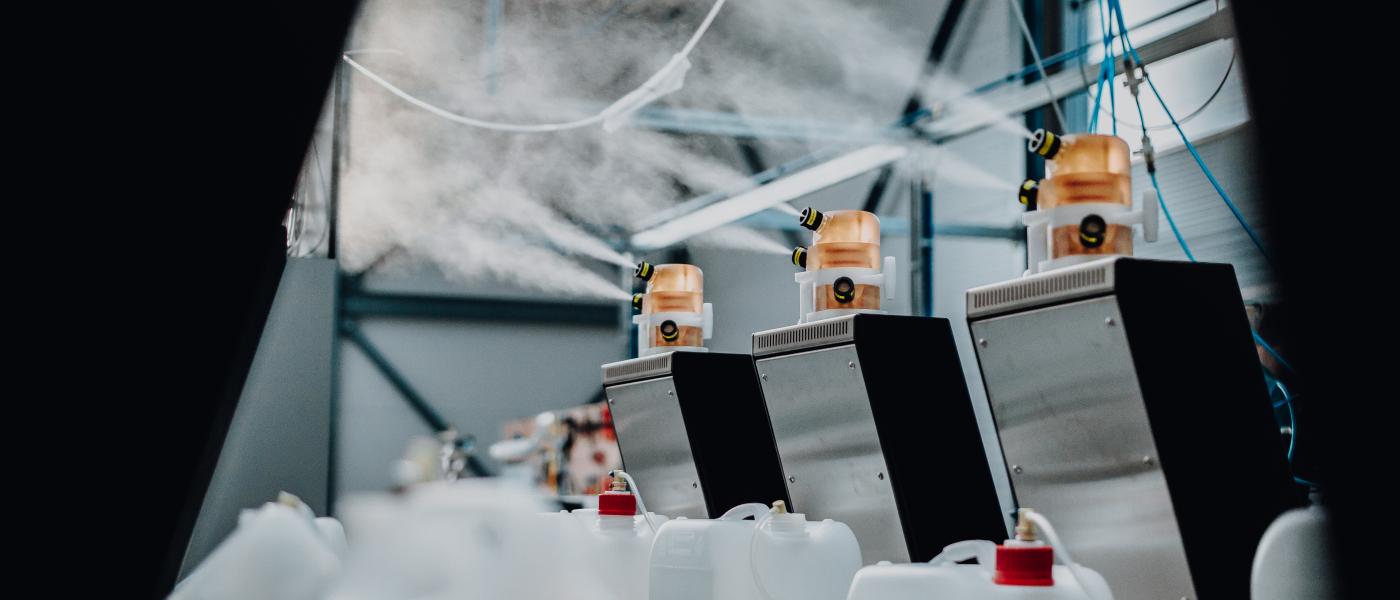Cycle parameters
In principle, a decontamination process carried out in normal environmental conditions can be rendered without the need of preconditioning phase regarding temperature and humidity. However, these are factors to be considered during cycle development and validation. Studies conducted by an important pharmaceutical company showed that RH conditions between 40-70% and temperatures between 17-27°C can be properly validated to 6-log reduction by adjusting H2O2 initial liquid concentration. The cycle development strategy should consider the worst case situation and try to fix the concentration of H2O2 for simplifying validation.
Solidfog typically recommends a dilution with 12%, which renders the best compromise between sporicidal efficiency and compatibility with materials used in these areas. For such concentration, the ideal starting conditions are 40% RH and 20°C but other starting conditions can be challenged as the results are also influenced by other factors like the overall volume, the related surfaces to be treated and the geometry of the area.
Microbiologist have reported in some cases for killing certain virus or bacteria is more convenient a higher humidity, providing a higher level of micro-condensation.
In conclusion, there’s not a fixed rule to be followed and only after a case by case analysis and a job of cycle development (cycle trials), it will be possible to determine the cycle parameters to be validated.
Methodology to develop decontamination solutions
1. Data collection
The process starts with the collection of data :
- Cleanroom area architecture (layout) with identification of equipment and furniture.
- Overall volume.
- Defining areas with common AHU that need to be decontaminated together.
- HVAC system design and performance (Air Changes per Hour).
- Frequency of decontaminations per area and expected lead times.
- Expected log-reduction.
- Information about the typical environmental conditions (Relative Humidity and Temperature) and peak levels along the different year’s season.
- Information about the cleaning or disinfecting procedures performed before the decontamination to avoid chemical reactions and corrosion problems.
- Information about specific hots or cold spots or surfaces that could have an adverse effect over H2O2 decontamination or produce too much condensation.
2. Proposal as first approach
We make a proposal as a first approach including:
- Position and number of units as well as the direction of the spray heads according to layout and internal elements (machinery, furniture, etc).
- Quantity of biocide based on a fixed concentration of H2O2.
- Estimation of cycle phase lead times (conditioning and contact phase) as per targeted log reduction. However, these values will always be an estimate. Lead times are highly dependent on the adsorption capacity of materials remaining in the room (i.e. filters), the concentration of H2O2, the architecture and the performance of air renewal provided by the HVAC system, etc.
3. Cycle development and validation
The definition of cycle parameter values (quantity of biocide, injection rates, pressure, etc) will be based on Solidfog’s experience on a case by case basis. The purpose of cycle development is to find a good compromise between efficiency and decontamination assurance, consumption of biocide and cycle times, challenging the system on worst case conditions. Typically, these tests are initially performed using chemical indicators.
Right after making some adjustments, we proceed with enzymatic indicators to know the level of log-reduction and finally this is confirmed with biological indicators. Validation is the last step and it should be carried out only after cycle development has been successfully finished. In case the BIs give strange results, it is 3 units per position as proactive measure to ensure they are not due to wrong handling or the use of rogue biological indicators.
Once the results show no growth, we have the parameters of the equipment in order to ensure reproducibility. These are: the quantity of biocide, the position and direction of the spray nozzles, the pressure of injection and the flow. For this reason, it is paramount that the equipment provides monitoring and recording systems to ensure that such cycle parameters are met according to validation pattern, as it is in the case of Solidfog.

